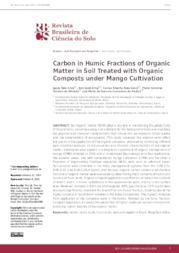Carbon in humic fractions of organic matter in soil treated with organic composts under mango cultivation.
Carbon in humic fractions of organic matter in soil treated with organic composts under mango cultivation.
Author(s): SILVA, J. R.; SILVA, D. J.; GAVA, C. A. T.; OLIVEIRA, T. C. T. de; FREITAS, M. do S. C. de
Summary: Soil organic matter (SOM) plays a key role in maintaining the productivity of tropical soils, providing energy and substrate for the biological activity and modifying the physical and chemical characteristics that ensure the maintenance of soil quality and the sustainability of ecosystems. This study assessed the medium-term effect (six years) of the application of five organic composts, produced by combining different agro-industrial residues, on accumulation and chemical characteristics of soil organic matter. Treatments were applied in a long-term experiment of organic management of mango (OMM) initiated in 2005 with a randomized block design with four replications. Two external areas, one with conventional mango cultivation (CMM) and the other a fragment of regenerating Caatinga vegetation (RCF), were used as reference areas. Soil samples were collected in the three management systems from the 0.00-0.05, 0.05-0.10, and 0.10-0.20 m layers, and the total organic carbon content and chemical fractions of organic matter were evaluated by determining the C contents of humin and humic and fulvic acids. Organic compost application significantly increased the contents of total C and C in humic substances in the experimental plots, mainly in the surface layer. However, compost 3 (50 % coconut bagasse, 40 % goat manure, 10 % castor bean residues) significantly increased the level of the non-humic fraction, probably due to the higher contents of recalcitrant material in the initial composition. The highest increases from application of the composts were in the humin, followed by the fulvic fraction. Compost application increased the proportion of higher molecular weight components, indicating higher stability of the organic matter.
Publication year: 2016
Types of publication: Journal article
Unit: Embrapa Semi-arid Region
Observation
Some of Embrapa's publications are published as ePub files. To read them, use or download one of the following free software options to your computer or mobile device. Android: Google Play Books; IOS: iBooks; Windows and Linux: Calibre.
Access other publications
Access the Agricultural Research Database (BDPA) to consult Embrapa's full library collection and records.
Visit Embrapa Bookstore to purchase books and other publications sold by Embrapa.

